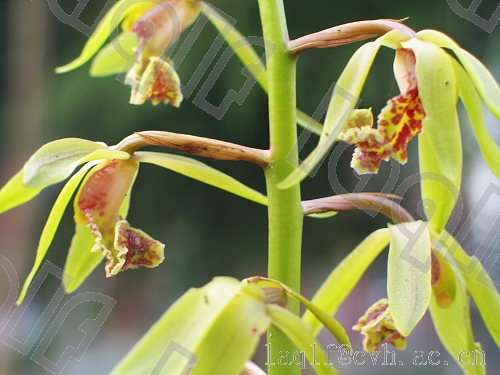





Common Name Faber's Cymbidium [English Plant Collector in Chiana late 1800's] - In China Hui Lan
Flower Size 2.4" [6 cm]
Found in central & southern China, Nepal and India in moist but open and well drained locales at elevations of 700 to 3000 meters as a small to large sized, warm to cold growing terrestrial with very small to inconspicuous pseudobulbs carrying 5 to 8, lorate, conduplicate basally, usually serrulate margined, transluscent veined leaves that blooms in the spring on an suberect to slightly curved, 14 to 20" [35 to 50 cm] long, racemose, 5 to 11 flowered inflorescence with linear-lanceolate bracts and carrying fragrant flowers
Synonyms
References W3 Tropicos, Kew Monocot list , IPNI ; Die Orchideen lieferung 24 Schlechter/Brieger 1991; Native Orchids of China in Colour Singchi, Zhanhuo and Yibo 1999 photo fide; Native Orchids of Shaanxi - Shaanxi Science & Technology Press 2007 photo fide; Orchids of India A Glimpse Misra 2007; The Genus Cymbidium Du Puy & Cribb 2007 photo/drawing fide; Native Orchids From Gaoligongshan Maountains, China Xiaohua, Xiaodong and Xiaochun 2009 photo fide; A Field Guide to the Orchids of China Singchi, Zhongjian, Yibo, Xiaohua and Zhanhuo 2009 photo fide; Flora of China Vol 25 Zhengyi, Raven & Deyuan 2009; Flora of China Vol 25 Illustrations Zhengyi, Raven & Deyuan 2010 drawing fide; Orchids of Huanglong Perner, Tang Si-Yuan 2007 photos fide;
| Scientific classification | |
|---|---|
| Kingdom: | Plantae |
| (unranked): | Angiosperms |
| (unranked): | Monocots |
| Order: | Asparagales |
| Family: | Orchidaceae |
| Subfamily: | Epidendroideae |
| Tribe: | Cymbidieae |
| Subtribe: | Cymbidiinae |
| Genus: | Cymbidium faberi |
Cymbidium cerinum Schlechter; C. faberi f. viridiflorum S. S. Ying; C. fukienense T. K. Yen; C. oiwakense Hayata; C. scabroserrulatum Makino; Eulophia yunnanensis Rolfe; Semiphajus evrardii Gagnepain.
Plants terrestrial, autotrophic. Pseudobulbs inconspicuous. Leaves 4-8, suberect, 25-80 × 0.7-1.2 cm, with transparent veins, conduplicate at base, not articulate, margin sharply serrate. Inflorescence arising from axil of uppermost leaf, suberect or slightly curved, 35-50(-80) cm; peduncle with many long sheaths; rachis 5-11- or more flowered; floral bracts linear-lanceolate, usually 10-20 × 2-5 mm, ca. 1/2 as long as ovary. Flowers usually very fragrant; pedicel and ovary 20-26 mm; sepals and petals pale yellowish green; lip pale yellowish green with purplish red patches. Sepals sublanceolate-oblong or narrowly obovate, 25-35 × 6-8 mm, apex acute. Petals oblong-ovate, 22-30 × 7-9 mm, apex acute; lip oblong-ovate, 20-25 mm, not fused to basal margins of column, 3-lobed; lateral lobes erect; mid-lobe strongly recurved, ligulate, 12-16 × 5-10 mm, margin usually crisped; disk papillate or puberulent, with 2 longitudinal lamellae extending from base of lip to base of mid-lobe; lamellae convergent toward their apices and forming a short tube. Column slightly arcuate, 12-16 mm, narrowly winged; pollinia 4, in 2 pairs, broadly ovoid. Capsule narrowly subellipsoid, 50-55 × ca. 20 mm. Fl. Mar-May, fr. Jul-Sep. 2n = 40, 42*, 43, 44.
Damp but well-drained slopes, open shrubby places; 700-3000 m. Anhui, N Fujian, S Gansu, Guangdong, Guangxi, Guizhou, S Henan, Hubei, Hunan, Jiangxi, S Shaanxi, Sichuan, Taiwan, E Xizang, Yunnan, Zhejiang [N India, Nepal].
References
1.Ref 1
2.Ref 2
3.Ref 3
4.Ref 4
No comments:
Post a Comment